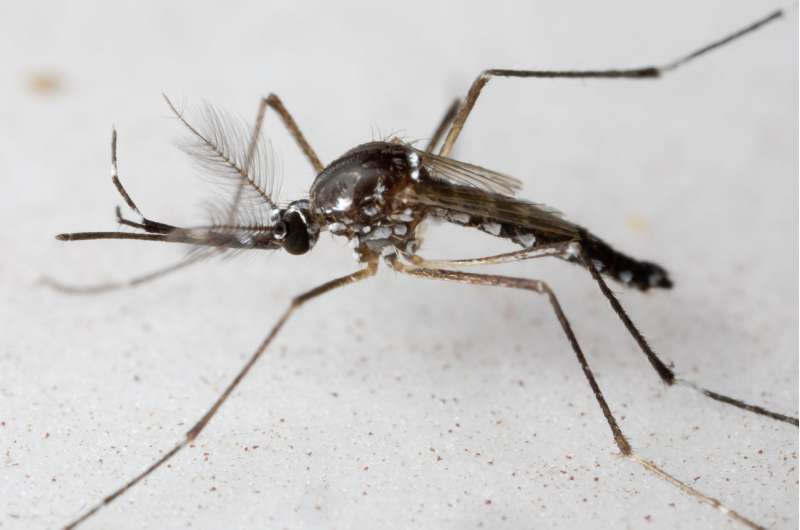Several emerging mosquito-management methods require the storage, transport, and delivery of mosquitoes to precise locations. There, lab-reared mosquitoes -- for instance, males that have been sterilized -- mix with wild mosquitoes and hinder the population's ability to reproduce or transmit disease to humans. But, getting those mosquitoes from the lab into the wild presents logistical challenges, such as how the mosquitoes should be packed for transport. A project led by researchers at New Mexico State University sought to answer how tightly male Aedes aegypti mosquitoes could be packed together. Surprisingly, the highest density the researchers tested -- 240 mosquitoes per cubic centimeter, or about 1,200 to a teaspoon -- resulted in the highest survival rate (about 85 percent) in an overnight-shipping test. This male Ae. aegypti, like many of the mosquitoes in the test, emerged with some missing scales and slight damage to its wings but was still able to fly. Credit: Geoffrey M. Attardo, Ph.D., University of California, Davis/Journal of Insect Science
In the global effort to prevent diseases transmitted by mosquitoes, several promising new techniques for reducing their populations are all based on a single concept: fighting mosquitoes with mosquitoes.
Some methods send sterilized mosquitoes out into the wild, where they mate with females but produce no offspring, thereby causing their numbers to plummet. Other methods use mosquitoes infected with naturally occurring bacteria that interfere with their ability to reproduce or their ability to carry disease pathogens. And still others use genetically modified mosquitoes to the same effect.
But all of these methods present a fundamental challenge: How do you take thousands, or even millions, of mosquitoes born in a lab and get them out into the wild?
That's a question that New Mexico State University's Hae-Na Chung and a team of fellow researchers hope to answer, and their first study on the subject reveals a surprising discovery about just how tightly live mosquitoes can be packed up.
In an experiment that tested how well mosquitoes survived a 24-hour shipping process, Chung and colleagues found that the optimal protocol was to pack them at a rate of about 240 mosquitoes per cubic centimeter—or, in other words, nearly 1,200 mosquitoes to a teaspoon.
"We started our experiments in 50 milliliter tubes and quickly learned that you have to raise a lot of mosquitoes to fill such a tube—10,000 males fit in one. We then switched to 10 milliliter syringes and were astonished how many mosquitoes you can fit into one, up to 2,500," says Immo Hansen, Ph.D., associate professor at NMSU. Chung is a lab technician in Hansen's Molecular Vector Physiology Lab at the university.
Credit: Julia Vulcan, New Mexico State University/Journal of Insect Science
Chung, Hansen, and colleagues at New Mexico State University; Michigan State University; the University of California, Davis; and unmanned aerial systems firm M3 Consulting Group have shared their findings in a report published today in the open-access Journal of Insect Science.
In the 1950s, a pest-control method known as the sterile insect technique was first successfully developed and deployed to eradicate the screwworm fly in the southern United States, and it has since been replicated in several other settings against other insect pests. Flies can be transported in their pupal form in crates by the thousands, and they can be released at a central point from which they will fly away across large distances. Mosquitoes, on the other hand, are more delicate, and an adult mosquito will fly no more than about 200 meters in its lifetime. That means mosquitoes released for population management must be physically delivered in batches to precise locations. Unmanned aerial vehicles—i.e., drones—are a likely candidate for this job, but they need to be equipped with release systems that ensure the mosquitoes make it to their destination alive and fit to fly.
To explore how such delivery systems might be designed, Chung and colleagues also subjected Aedes aegypti mosquitoes—a primary vector of yellow fever, Zika, and dengue—to storage at various temperatures, and they found 14 degrees Celsius (57.2 degrees Fahrenheit) resulted in the highest survival rates. They then conducted the shipping and handling experiment at that temperature and tested various compaction rates.
To pack the mosquitoes—all males, as would be the case in use of the sterile insect technique—the researchers placed a precise number of mosquitoes in a 10-milliliter syringe tube (see video) and inserted the plunger to compress them to the 1-milliliter mark (1 cubic centimeter). Then, for the shipping test, those tubes were packed securely in a Styrofoam container with a cooling element and shipped via overnight courier from Las Cruces, New Mexico, to Davis, California. Upon arrival, they were immediately released and examined for survival rate and damage by research team members at UC Davis.
At 240 mosquitoes per cubic centimeter, the highest density the researchers tried, many mosquitoes emerged with missing scales, and some had slightly damaged wings, but the tight packing appears to have kept the mosquitoes otherwise snug and secure.
"The high mortality of the not-so-densely packed mosquitoes in our real-world shipping assay was unexpected," says Hansen. "We hypothesize that the vibrations during transport, especially during the flight, affected the loosely packed mosquitoes more than the densely packed ones."
As the application of the sterile insect technique and its variants for mosquitoes continues to grow, further research on mosquito storage and transport will be necessary, looking at factors such as other shipping conditions and other mosquito species. For instance, "the big question that remains after this study is how fit male mosquitoes are after shipping. We will address this problem with semi-field experiments next year," Hansen says.
More information: "Toward Implementation of Mosquito Sterile Insect Technique: The Effect of Storage Conditions on Survival of Male Aedes aegypti Mosquitoes (Diptera: Culicidae) During Transport," Journal of Insect Science (2018). DOI: 10.1093/jisesa/iey103
Provided by Entomological Society of America























